Sir John Monash, Personal Files Book 6, 12 July - 3 August 1915, Part 1
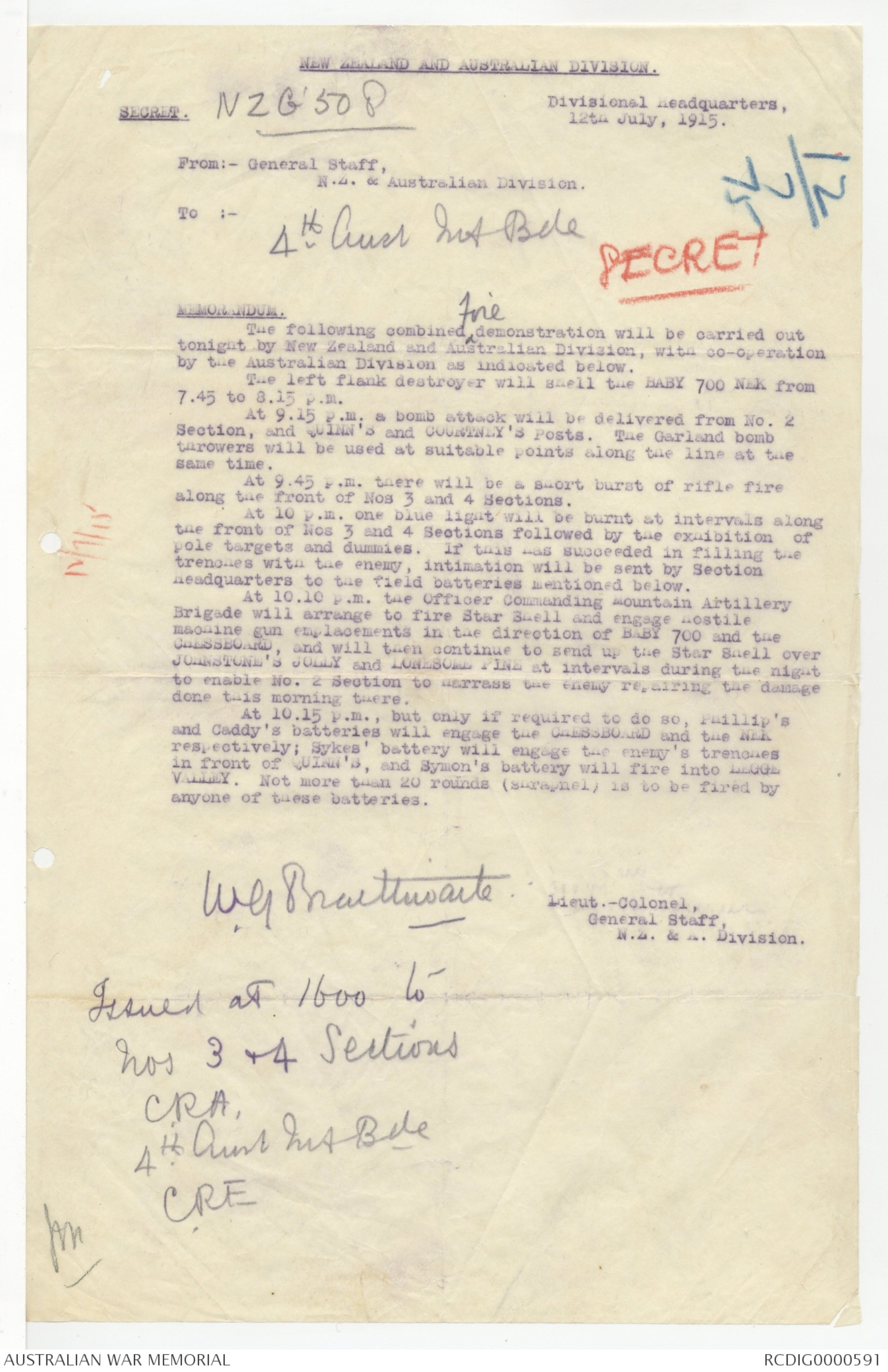
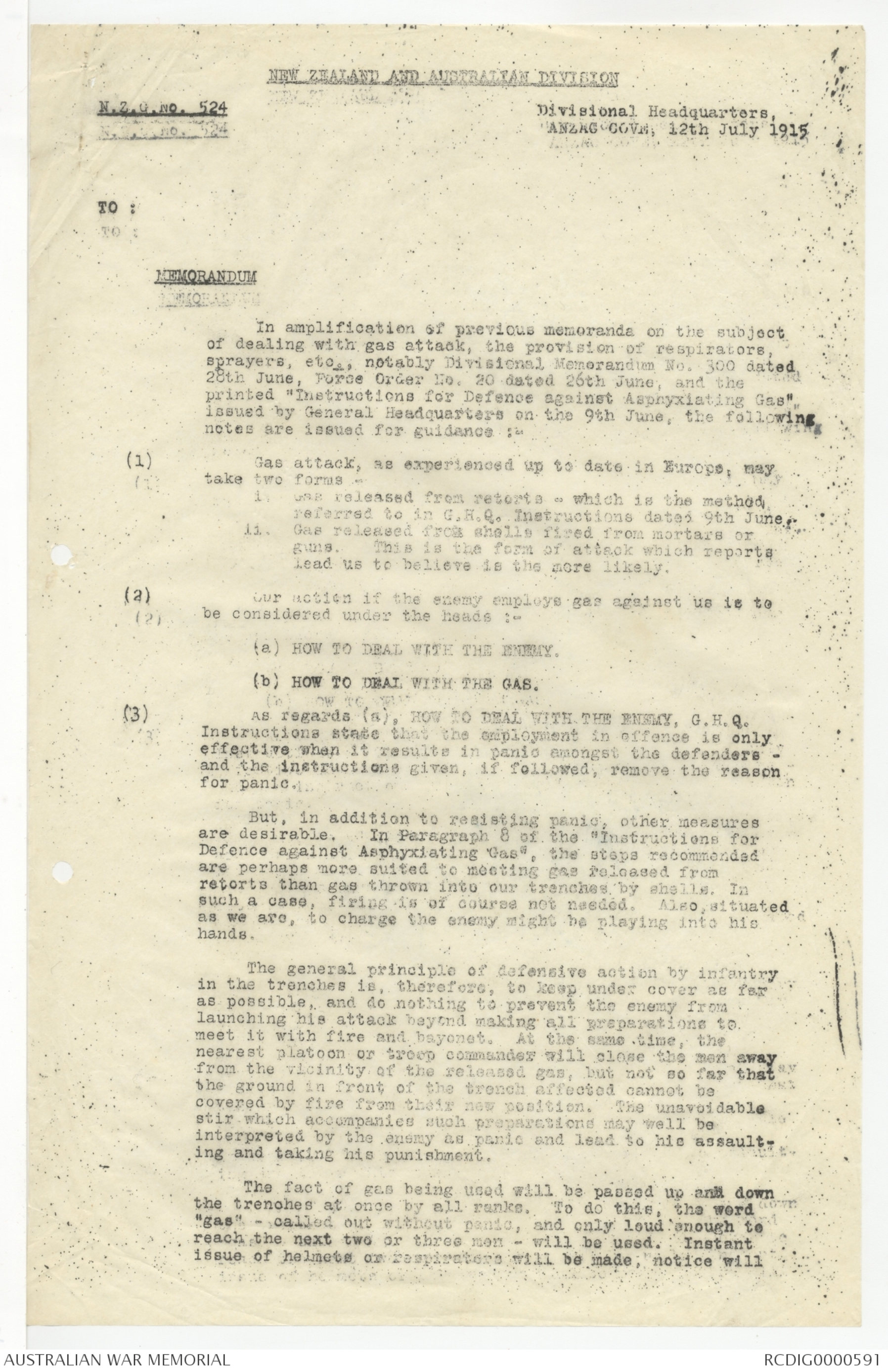
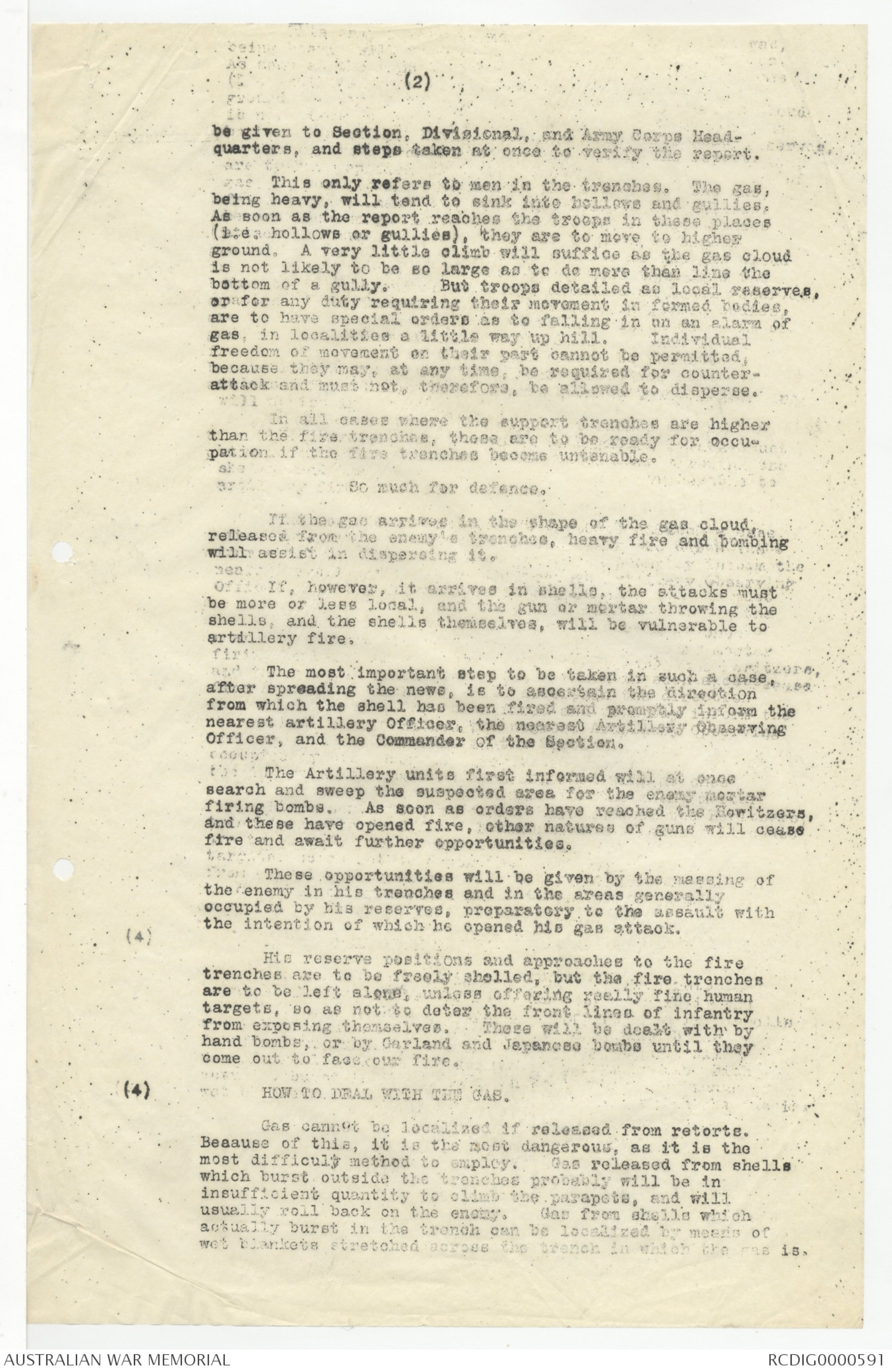
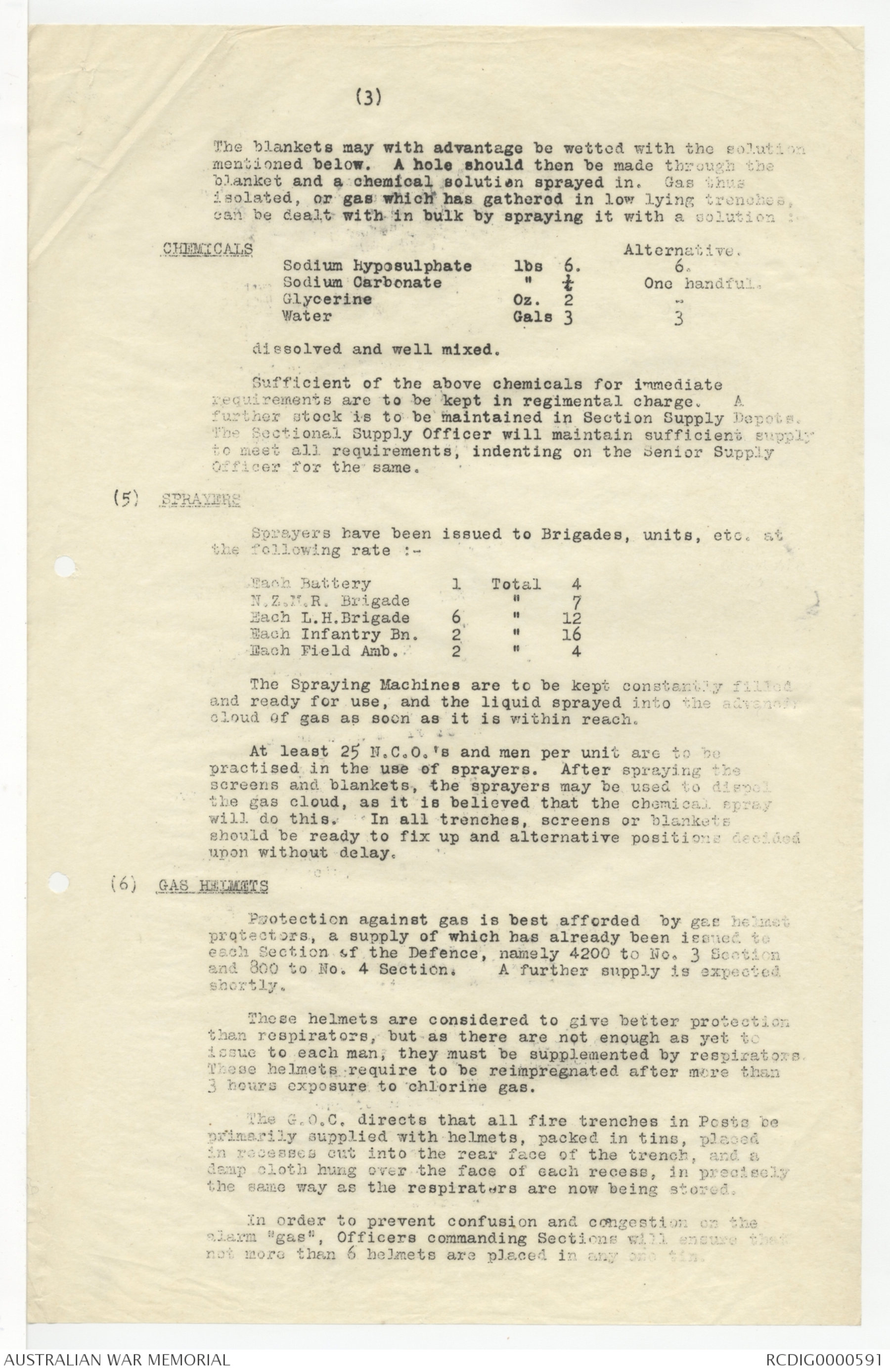
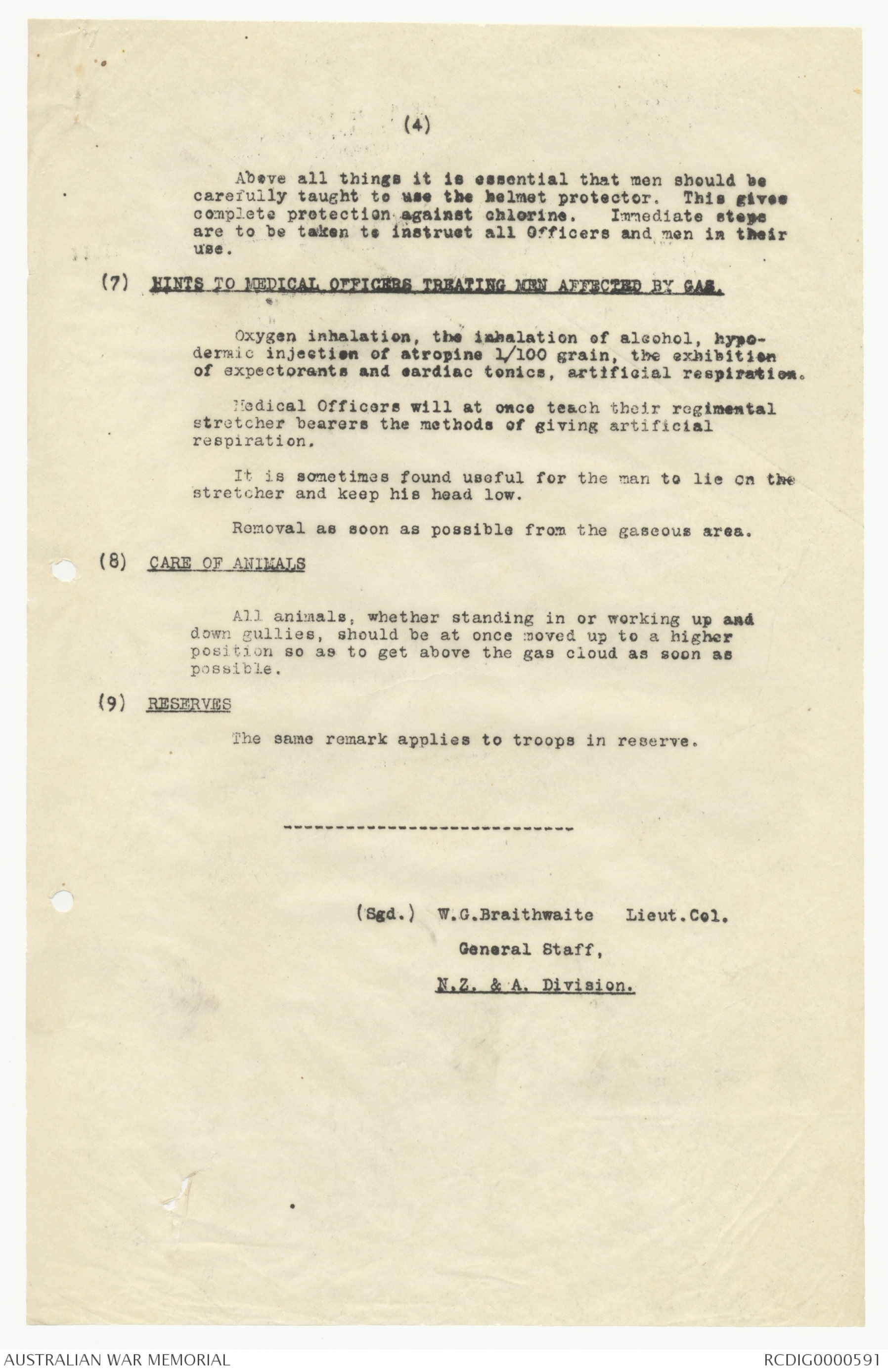
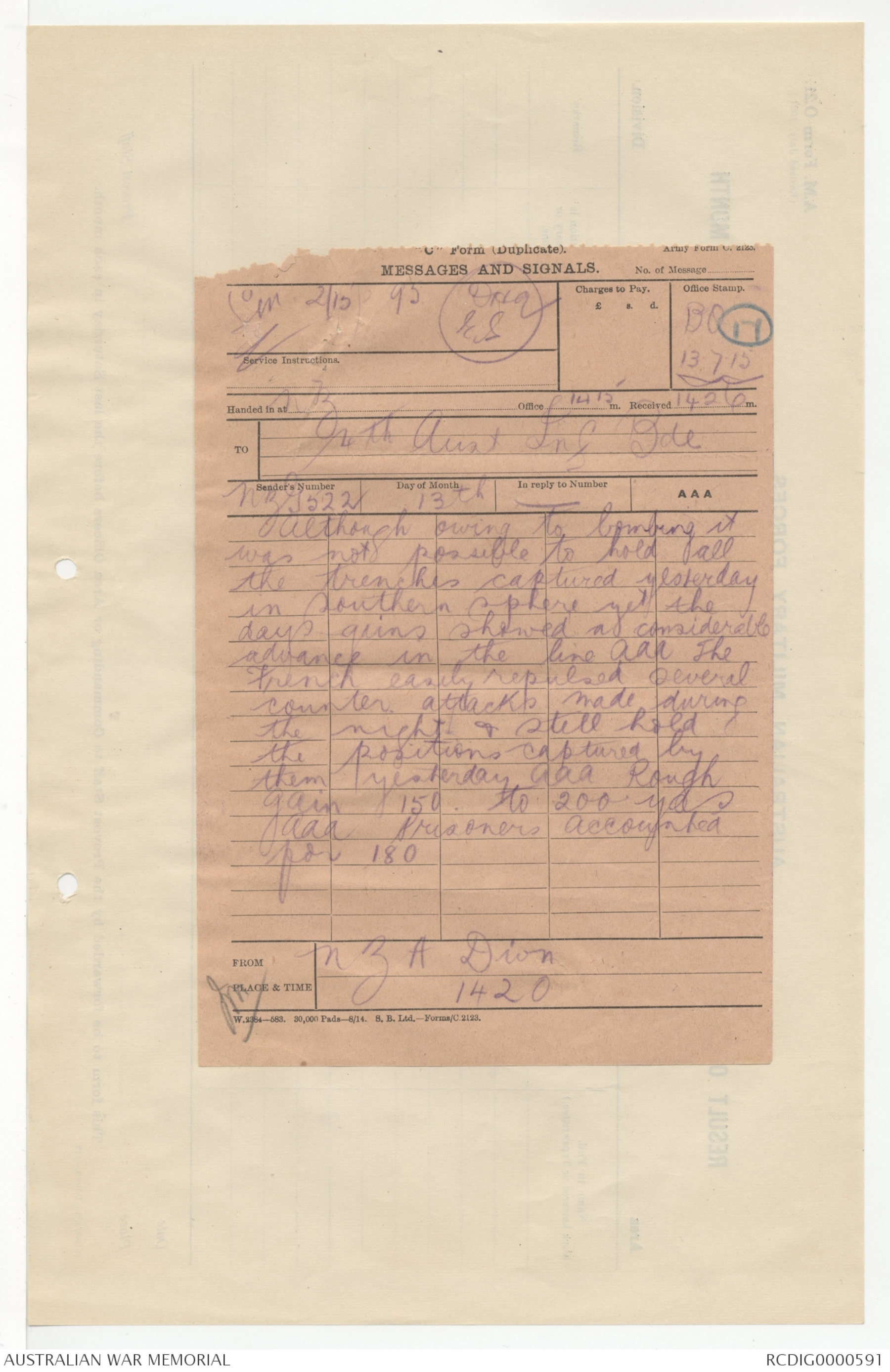
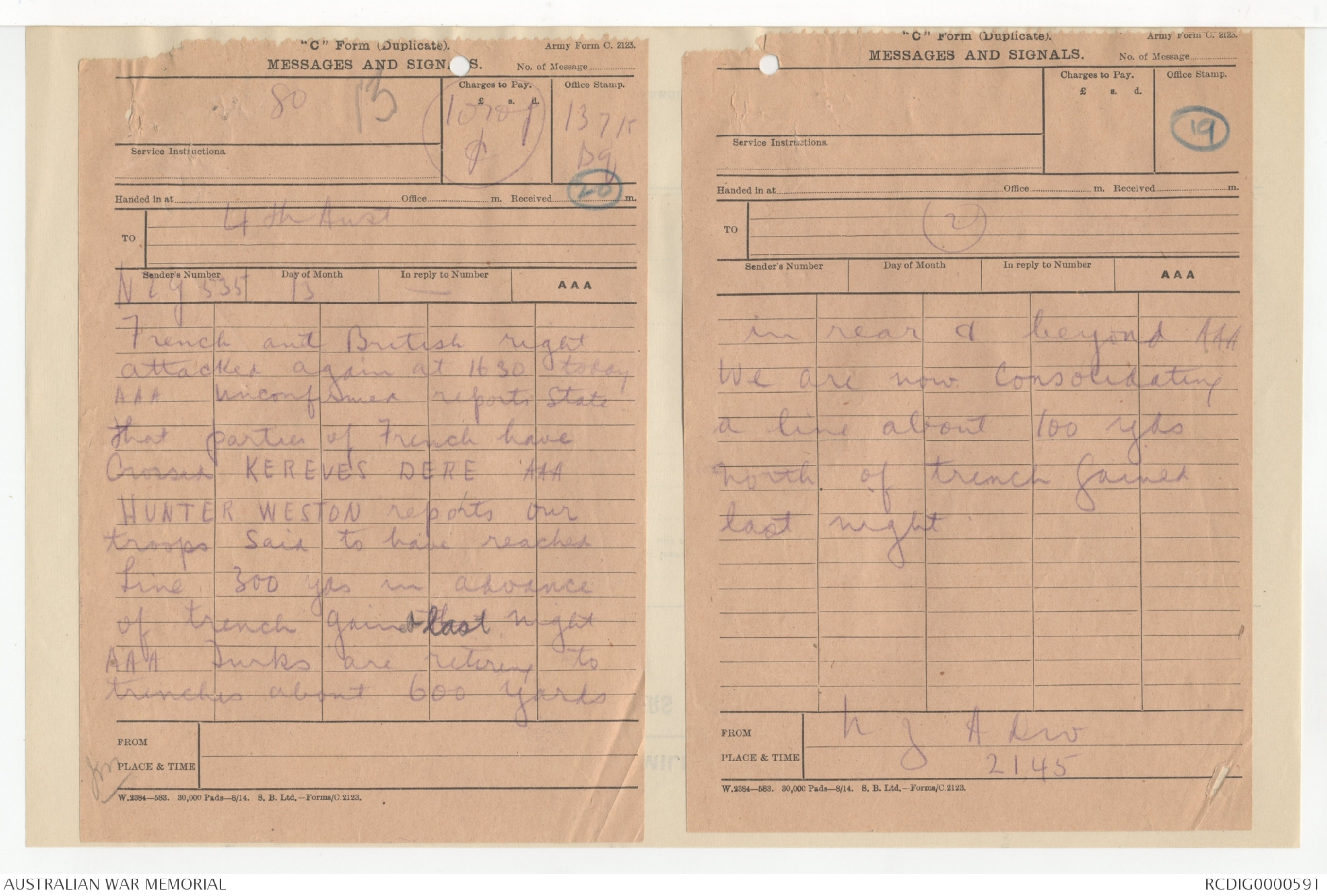
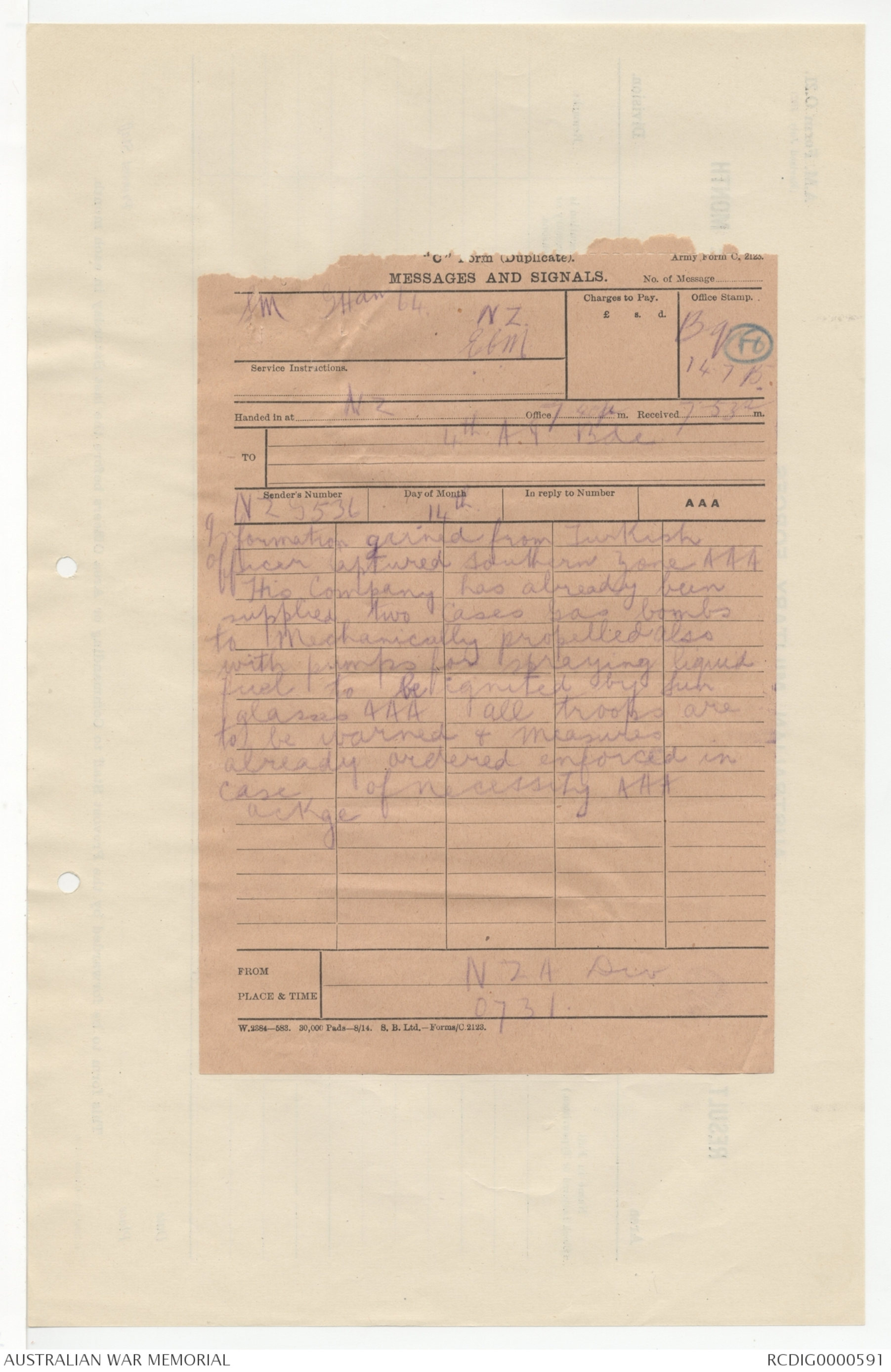
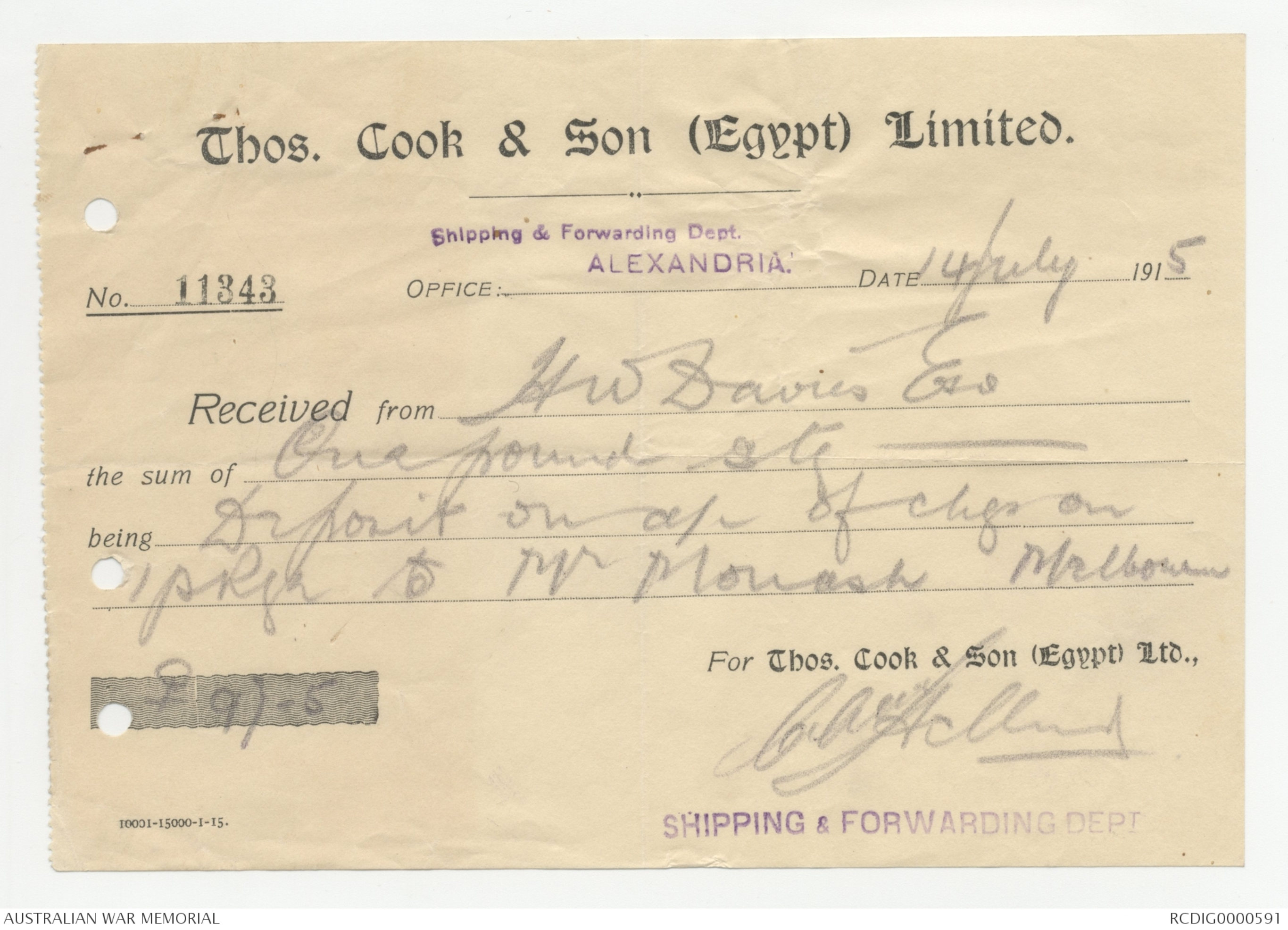
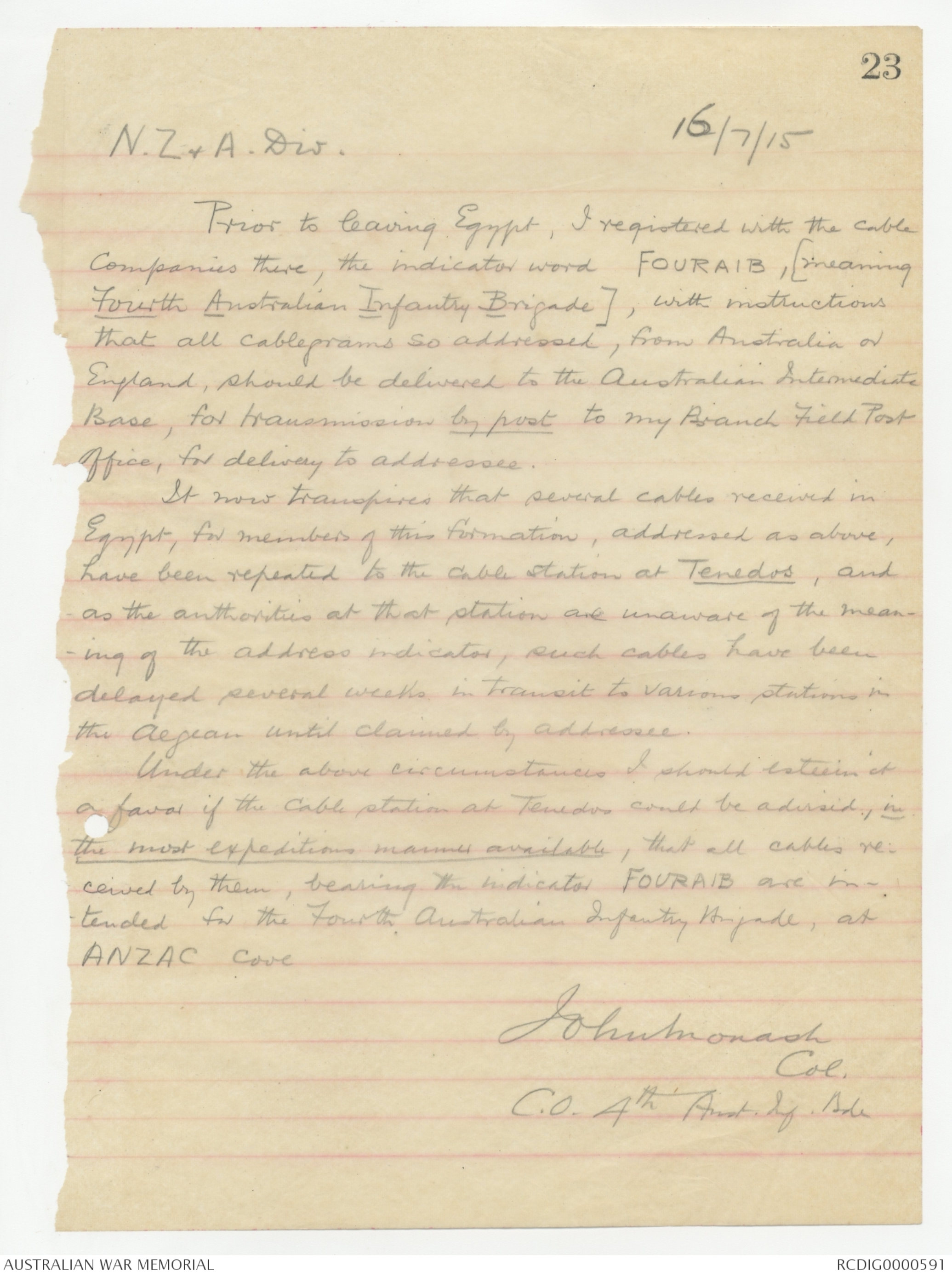
NEW ZEALAND AND AUSTRALIAN DIVISION.
SECRET. NZG 508
Divisional headquarters,
12th July, 1915.
From:- General Staff,
N.Z. & Australian Division.
To:-
4th Aust Inf Bde
SECRET
[*12/7 15*]
MEMORANDUM
The following combined, ^fire demonstration will be carried out
tonight by New Zealand and Australian Division, with co-operation
by the Australian Division as indicated below.
The left flank destroyer will shell the BABY 700 NEK from
7.45 to 8.15 p.m.
At 9.15 p.m; a bomb attack will be delivered from No. 2
Section, and QUINN’S and COURTNEY’S Posts. The Garland bomb
throwers will be used at suitable points along the line at the
same time.
At 9.45 p.m. there will be a short burst of rifle fire
along the front of Nos 3 and 4 Sections.
At 10 p.m. one blue light will be burnt at intervals along
[*12/7/15*] the front of Nos 3 and 4 Sections followed by the exhibition of
pole targets and dummies. If this has succeeded in filling the
trenches with the enemy, intimation will be sent by Section
Headquarters to the field batteries mentioned below.
At 10.10 p.m. the Officer Commanding Mountain Artillery
Brigade will arrange to fire Star Shell and engage hostile
machine gun emplacements in the direction of BABY 700 and the
CHESSBOARD, and will then continue to send up the Star Shell over
JOHNSTONE'S JOLLY and LONESOME PINE at intervals during the night
to enable No. 2 section to harass the enemy repairing the damage
done this morning there.
At 10.15 p.m., but only if required to do so, Phillip's
and Caddy's batteries will engage the CHESSBOARD and the NEK
respectively; Sykes' battery will engage the enemy's trenches
in front of QUINN'S, and Symon's battery will fire into LEGGE
VALLEY. Not more than 20 rounds (shrapnel) is to be fired by
anyone of these batteries.
WG Braithwaite
Lieut.-Colonel,
General Staff
N.Z.& A. Division.
Issued at 1600 to
Nos 3 & 4 Sections
CRA,
4th Aust Inf Bde
CRE
JM.
.
..
NEW ZEALAND AND AUSTRALIAN DIVISION
.N.Z.G.No. 524
Divisional Headquarters
ANZAC COVE, 12 July 1915
To:
MEMORANDUM
In amplification of previous memoranda on the subject
of dealing with gas attack, the provision of respirators,
sprayers, etc., notably Divisional Memorandum No. 300 dated
28th June, Force Order No. 20 dated 26th June, and the
printed "Instructions for Defence against Asphyxiating Gas"
issued by General Headquarters on the 9th June, the following
notes are issued for guidance:-
(1) Gas attack, as experienced up to date in Europe, may
take two forms
i. Gas released from retorts - which is the method
referred to in G.H.Q. Instructions dated 9 June.
ii. Gas released from shells fired from mortars or
guns. This is the form of attack which reports
lead us to believe is the more likely.
(2) Our action if the enemy employs gas against us is to
be considered under the heads :-
(a) HOW TO DEAL WITH THE ENEMY.
(b) HOW TO DEAL WITH THE GAS.
(3) As regards (a), HOW TO DEAL WITH THE ENEMY, G.H.Q.
Instructions state that the employment of offence is only
effective when it results in panic amongst the defenders -
and the instructions given, if followed, remove the reason
for panic.
But, in addition to resisting panic, other measures
are desirable. In Paragraph 8 of the "Instructions for
Defence against Asphyxiating Gas", the steps recommended
are perhaps more suited to meeting gas released from
retorts than gas thrown into our trenches by shells. In
such a case, firing is of course not needed. Also, situated
as we are, to charge the enemy might be playing into his
hands.
The general principle of defensive action by infantry
in the trenches is, therefore, to keep under cover as far
as possible, and do nothing to prevent the enemy from
launching his attack beyond making all preparations to
meet it with fire and bayonet. At the same time, the
nearest platoon or troop commander will close the men away
from the vicinity of the released gas, but not so far that
the ground in front of the trench affected cannot be
covered by fire from their new position. The unavoidable
stir which accompanies such preparations may well be
interpreted by the enemy as panic and lead to his assaulting
and taking his punishment.
The fact of gas being used will be passed up and down
the trenches at once by all ranks. To do this, the word
"gas" - called out without panic, and only loud enough to
reach the next two or three men - will be used. Instant
issue of helmets or respirators will be made, notice will
(2)
be given to Section, Divisional and Army Corps Headquarters,
and steps taken at once to verify the report.
This only refers to men in the trenches. The gas,
being heavy, will tend to sink into hollows and gullies.
As soon as the report reaches the troops in these places
(i.e. hollows or gullies), they are to move to higher
ground. A very little climb will suffice as the gas cloud
is not likely to be so large as to do more than line the
bottom of a gully. But troops detailed as local reserves,
or for any duty requiring their movement in formed bodies,
are to have special orders as to falling in on an alarm of
gas, in localities a little way up hill. Individual
freedom of movement on their part cannot be permitted,
because they may, at any time, be required for counter-
attack and must not, therefore, be allowed to disperse.
In all cases where the support trenches are higher
than the fire trenches, these are to be ready for occupation
if the fire trenches become untenable.
So much for defence.
If the gas arrives in the shape of the gas cloud,
released from the enemy's trenches, heavy fire and bombing
will assist in dispersing it.
If, however, it arrives in shells, the attacks must
be more or less local, and the gun or mortar throwing the
shells, and the shells themselves, will be vulnerable to
artillery fire.
The most important step to be taken in such a case,
after spreading the news, is to ascertain the direction
from which the shell has been fired and promptly inform the
nearest artillery Officer, the nearest Artillery Observing
Officer, and the Commander of the Section.
The Artillery units first informed will at once
search and sweep the suspected area for the enemy mortar
firing bombs. As soon as orders have reached the Howitzers,
and these have opened fire, other natures of guns will cease
fire and await further opportunities.
These opportunities will be given by the massing of
the enemy in his trenches and in the areas generally
occupied by his reserves, preparatory to the assault with
the intention of which he opened his gas attack.
(4) His reserve positions and approaches to the fire
trenches are to be freely shelled, but the fire trenches
are to be left alone, unless offering really fine human
targets, so as not to deter the front lines of infantry
from exposing themselves. These will be dealt with by
hand bombs, or by Garland and Japanese bombs until they
come out to face our fire.
(4) HOW TO DEAL WITH THE GAS.
Gas cannot be localized if released from retorts.
Because of this, it is the most dangerous, as it is the
most difficult method to employ. Gas released from shells
which burst outside the trenches probably will be in
insufficient quantity to climb the parapets, and will
usually roll back on the enemy. Gas from shells which
actually burst in the trench can be localized by means of
wet blankets stretched across the trench in which the gas is.
(3)
The blankets may with advantage be wetted with the solution
mentioned below. A hole should then be made through the
blanket and a chemical solution sprayed in. Gas thus
isolated, or gas which has gathered in low lying trenches,
can be dealt with in bulk by spraying it with a solution:
CHEMICALS Alternative.
Sodium Hyposulphate 1lbs 6. 6.
Sodium Carbonate " 1/2 One handful.
Glycerine Oz. 2 "
Water Gals 3 3
dissolved and well mixed.
Sufficient of the above chemicals for immediate
requirements are to be kept in regimental charge. A
further stock is to be maintained in Section Supply Depots.
The Sectional Supply Officer will maintain sufficient supply
to meet all requirements, indenting on the Senior Supply
Officer for the same.
(5) SPRAYERS
Sprayers have been issued to Brigades, units, etc. at
the following rate :-
Each Battery 1 Total 4
N.Z.M.R. Brigade " 7
Each L.H.Brigade 6 " 12
Each Infantry Bn. 2 " 16
Each Field Amb. 2 " 4
The Spraying Machines are to be kept constantly filled
and ready for use, and the liquid sprayed into the advancing
cloud of gas as soon as it is within reach.
At least 25 N.C.O.'s and men per unit are to be
practised in the use of sprayers. After spraying the
screens and blankets, the sprayers may be used to dispel
the gas cloud, as it is believed that the chemical spray
will do this. In all trenches, screens or blankets
should be ready to fix up and alternative positions decided
upon without delay.
(6) GAS HELMETS
Protection against gas is best afforded by gas helmet
protectors, a supply of which has already been issued to
each Section of the Defence, namely 4200 to No. 3 Section
and 800 to No. 4 Section. A further supply is expected
shortly.
These helmets are considered to give better protection
than respirators, but as there are not enough as yet to
issue to each man; they must be supplemented by respirators.
These helmets require to be reimpregnated after more than
3 hours exposure to chlorine gas.
The G.O.C. directs that all fire trenches in Posts be
primarily supplied with helmets, packed in tins, placed
in recesses cut into the rear face of the trench, and a
damp cloth hung over the face of each recess, in precisely
the same way as the respirators are now being stored.
In order to prevent confusion and congestion on the
alarm "gas", Officers commanding Sections will ensure that
not more than 6 helmets are placed in any one tin.
(4)
Above all things it is essential that men should be
carefully taught to use the helmet protector. This gives
complete protection against chlorine. Immediate steps
are to be taken to instruct all Officers and men in their
use.
(7) HINTS TO MEDICAL OFFICERS TREATING MEN AFFECTED BY GAS.
Oxygen inhalation, the inhalation of alcohol, hypodermic
injection of atropine 1/100 grain, the exhibition
of expectorants and cardiac tonics, artificial respiration.
Medical Officers will at once teach their regimental
stretcher bearers the methods of giving artificial
respiration.
It is sometimes found useful for the man to lie on the
stretcher and keep his head low.
Removal as soon as possible from the gaseous area.
(8) CARE OF ANIMALS
All animals, whether standing in or working up and
down gullies, should be at once moved up to a higher
position so as to get above the gas cloud as soon as
possible.
(9) RESERVES
The same remark applies to troops in reserve.
-----------------
(Sgd.) W.G. Braithwaite Lieut. Col.
General Staff,
N.Z. & A. Division.
"C" Form (Duplicate).
Army Form C/2123
MESSAGES AND SIGNALS.
No. of Message
CM 2/15 93
DHQ ES
Charges to Pay.
£ s. d.
Office Stamp
BQ
17
13.7.15
Handed in at NZ Office 14:15 m. Received 14:26 m.
To 4th Aust Inf Bde
Sender Number
NZG522
Day of Month
13th
In reply to Number
A A A
Although owing to bombing it
was not possible to hold all
the trenches captured yesterday
in southern sphere yet the
days guns showed a considerable
advance in the line AAA The
French easily repulsed several
counter attacks made during
the night & still hold
the positions captured by
them yesterday. AAA Rough
gain 150 to 200 yds
AAA Prisoners accounted
for 180.
FROM NZA Divn
PLACE & TIME 1420
JM
W.2384-583 30,000 Pads-8/14. S.B. Ltd.-Forms/C.2123.
"C" Form (Duplicate).
Army Form C/2123
MESSAGES AND SIGNALS.
No. of Message
80
13
Charges to Pay. 1070 F
F
Office Stamp
13.7.15
Bq
20
Service Instructions.
Handed in at Office m. Received
TO 4th Aust
Sender's Number
NZG535
Day of Month
13
In reply to Number
-
A A A
French and British right
attacked again at 16.30 today
AAA Unconfirmed reports State
that parties of French have
Crossed KEREVES DERE AAA
HUNTER WESTON reports our
troops said to have reached
line 300 yds in advance
of trench gained last night
AAA Turks are retiring to
trenches about 600 yards
FROM
PLACE & TIME
JM
W.2384-583 30,000 Pads-8/14. S.B. Ltd.-Forms/C.2123.
"C" Form (Duplicate).
Army Form C/2123
MESSAGES AND SIGNALS.
No. of Message
Charges to Pay.
£ s. d.
Office Stamp
19
Bq
Service Instructions.
Handed in at Office m. Received m.
TO 4th Aust
Sender's Number
Day of Month
In reply to Number
A A A
in rear and beyond AAA
We are now consolidating
a line about 100 yds
north of trench gained
last night
FROM NZA Div
PLACE & TIME 2145
W.2384-583 30,000 Pads-8/14. S.B. Ltd.-Forms/C.2123.
"C" Form (Duplicate).
Army Form C/2123
MESSAGES AND SIGNALS.
No. of Message
SM GHan 64
NZ
EGM
Charges to Pay.
£ s. d.
Office Stamp
BQ 14.7.15
(18)
Handed in at NZ
Office 7.40pm.
Received 7.53pm.
TO 4th A.I Bde
Sender's Number
NZG536
Day of Month
14th
In reply to Number
A A A
Information gained from Turkish
Officer Captured southern zone AAA
His Company has already been
supplied two cases Gas bombs
to Mechanically propelled also
with pumps for spraying liquid
fuel to be ignited by sun
glasses AAA all troops are
to be warned & measures
already ordered enforced in
case of necessity AAA
Ackge
FROM NZA Div
PLACE & TIME 0731
W.2384-583 30,000 Pads-8/14. S.B. Ltd.-Forms/C.2123
Thos. Cook & Son (Egypt) Limited.
Shipping & Forwarding Dept.
No. 11343
OFFICE: ALEXANDRIA.
DATE 14 July 1915
Received from HW Davies Esq
the sum of One pound stg
being Deposit on a/c of chgs on
1 pkge to Mrs Monash Melbourne
[*?*]9/-5
For Thos. Cook & Son (Egypt) Ltd.,
[[?]] CA Holland
SHIPPING & FORWARDING DEPT
1001-15000-1-15.
23
N.Z & A Div.
16/7/15
Prior to leaving Egypt, I registered with the cable
Companies there, the indicator word FOURAIB, [meaning
Fourth Australian Infantry Brigade], with instructions
that all cablegrams so addressed, from Australia or
England, should be delivered to the Australian Intermediate
Base for transmission by post to my Branch Field Post
Office, for delivery to addressee.
It now transpires that several cables received in
Egypt, for members of this formation, addressed as above,
have been repeated to the cable station at Tenedos, and
as the authorities at that station are unaware of the meaning
of the address indicator, such cables have been
delayed several weeks in transit to various stations in
the Aegean until claimed by addressee.
Under the above circumstances I should esteem it
a favor if the Cable station at Tenidos could be advised, in
the most expeditious manner available, that all cables received
by them, bearing the indicator FOURAIB are intended
for the Fourth Australian Infantry Brigade, at
ANZAC Cove
John Monash
Col.
C.O. 4th Aust. Inf. Bde.
 Andrew Dobbin
Andrew DobbinThis transcription item is now locked to you for editing. To release the lock either Save your changes or Cancel.
This lock will be automatically released after 60 minutes of inactivity.